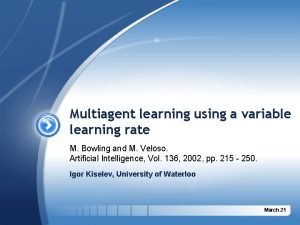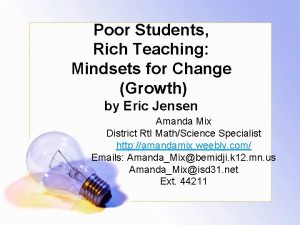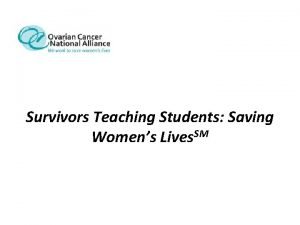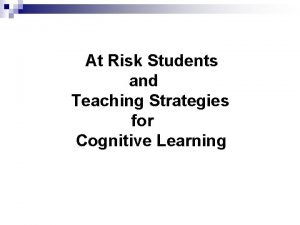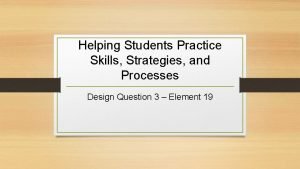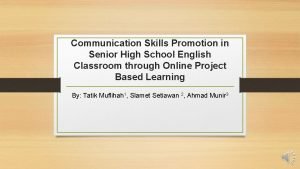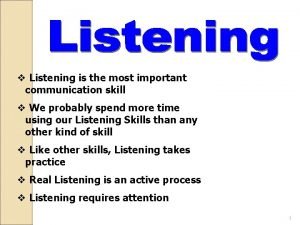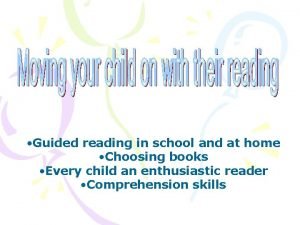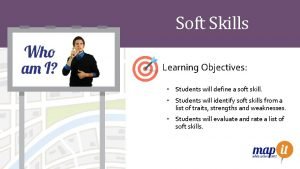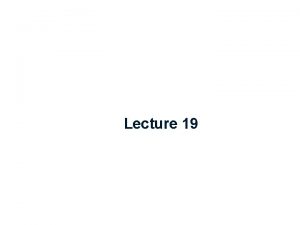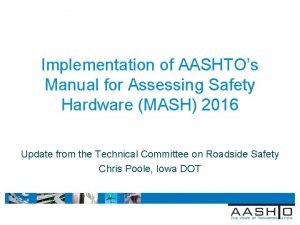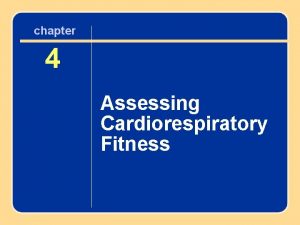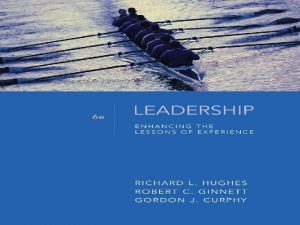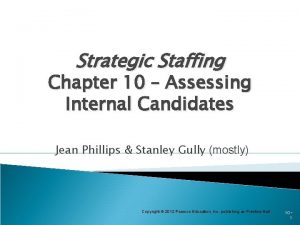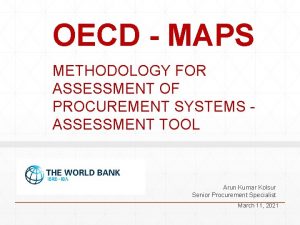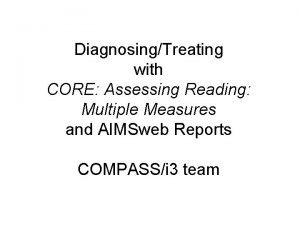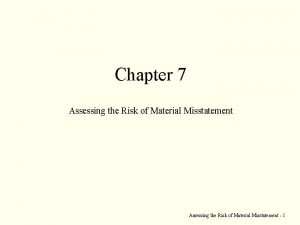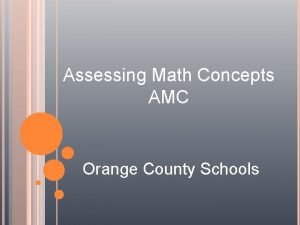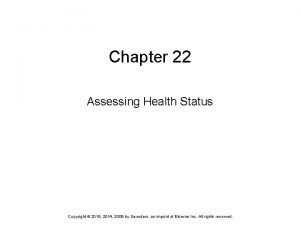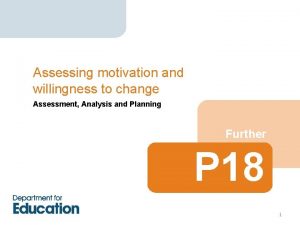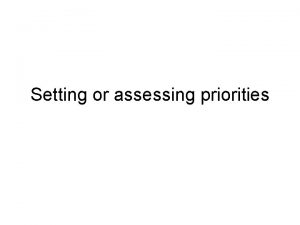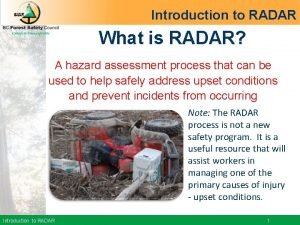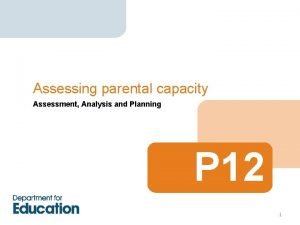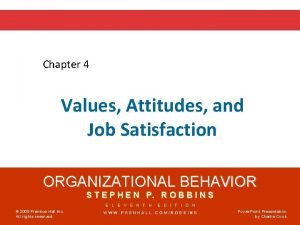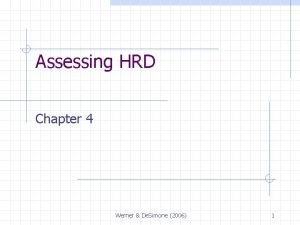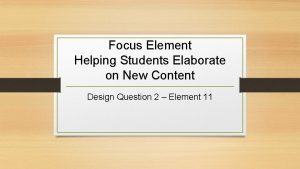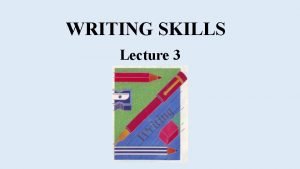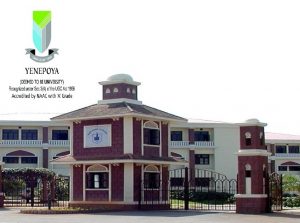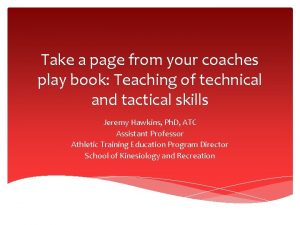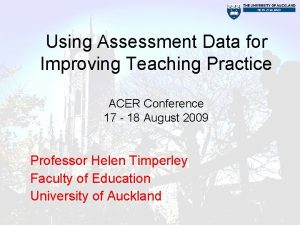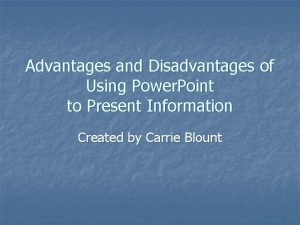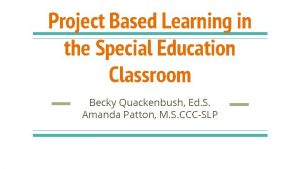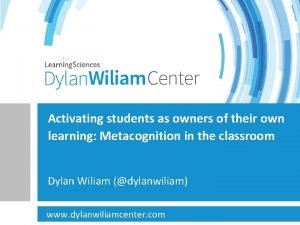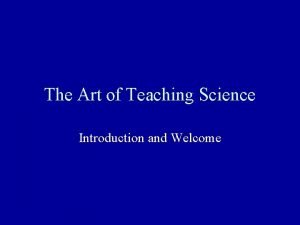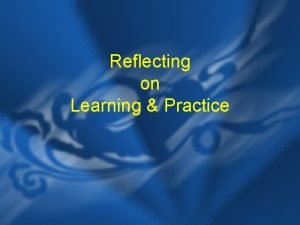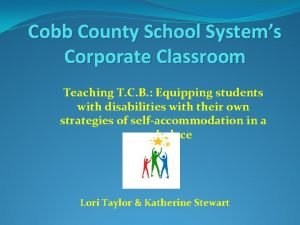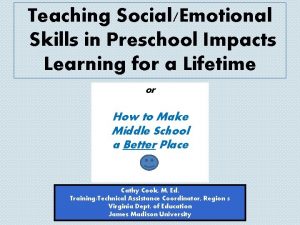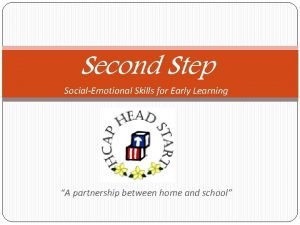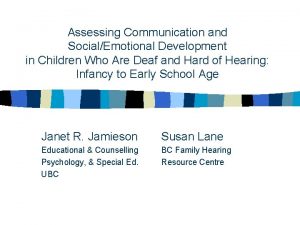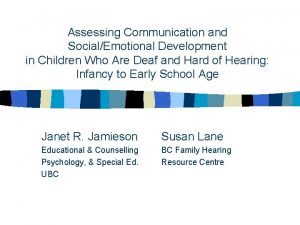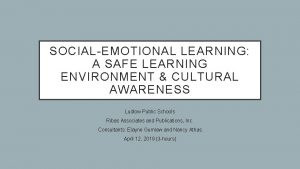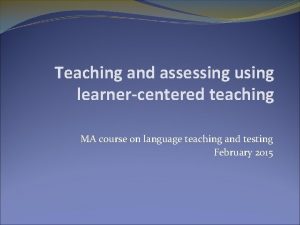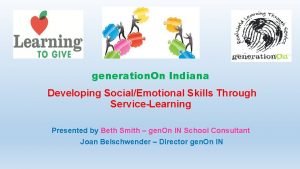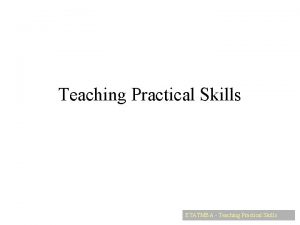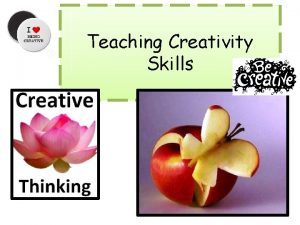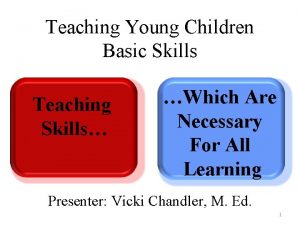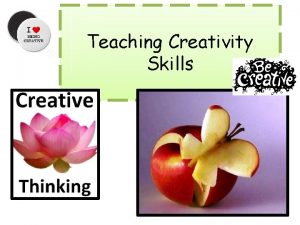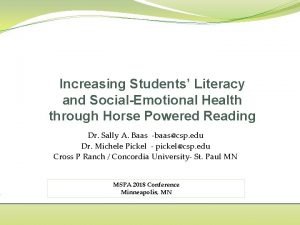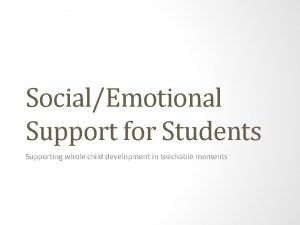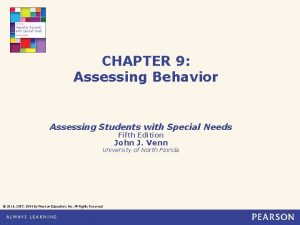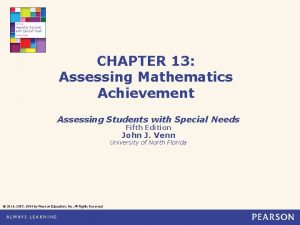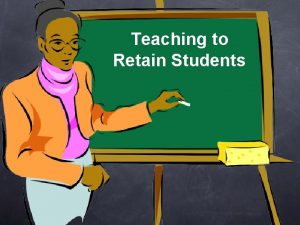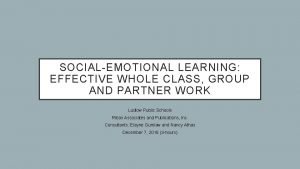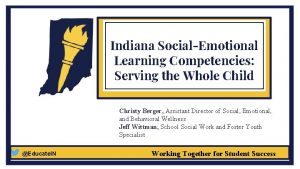Assessing Teaching Students SocialEmotional Learning Skills Using the




































































- Slides: 68

Assessing & Teaching Students Social-Emotional Learning Skills Using the SSIS SEL Classwide Intervention Program January 25, 2018 1

Presenters Michael Davies, Ph. D, is the Program Leader in Counselling at the Australian Institute of Professional Counsellors and is an Adjunct Associate Professor at Education and Professional Studies at Griffith University in Brisbane. He has researched and published in SEL and the application of the SSi. S in Australia with Steve Elliott since 2005, and has presented this research in national and international m. davies@Griffith. edu. au conferences. Stephen (Steve) Elliott, Ph. D, is the Mickelson Foundation Professor in the Sanford School of Social & Family Dynamics at Arizona State University, USA. He is the co-author with Frank Gresham of the Social Skills Rating System (SSRS; 1990) and of the Social Skills Improvement System (SSIS; 2008). He is the lead developer and co-author of the SSIS SEL Edition Assessments and Intervention Program in 2017. With this SSIS SEL edition, we created a new Screening & Progress Monitoring Scale, revised the Rating Forms & integrated and digitized all the interventions into the Classwide Intervention Program (CIP). Steve_Elliott@asu. edu Welcome Everybody! 2

You are about to enter a Highly Aligned and Integrated Assessment and Intervention System that is Evidence-Based and Proven to be Effective for teaching SEL Skills like those called for in ACARA’s Personal and Social Capabilities curriculum! 3

Session Overview • • • Social Emotional Learning: Definition & Background Screening All Students to Identify Strengths and Weaknesses Components of a S. A. F. E. R. SEL Intervention for all Children Implementation Steps for Using the Classwide Intervention Program (CIP) Questions & Answers Screening Intervention Assessment SSIS SEL Edition Screening/Progress Monitoring Scales SSIS SEL ed. Classwide Intervention Program (CIP) SSIS SEL Edition Rating Forms Fully Aligned Assessments that Measure the Same Skills Taught in the Intervention Program Evidence Based Treatment 4

We have Listened to Educators…. Data Source: Bridgeland, Bruce, & Hariharan (2013) Then responded with the SEL Edition CIP! 5

SSIS SEL Assessment & Intervention Components (2017) 6

SEL Definition & Policy and Practice Context

Social emotional learning (SEL) is defined as the “process of acquiring knowledge, skills, attitudes, and beliefs to identify and manage emotions; to care about others; to make good decisions; to behave ethically and responsibly; to develop positive relationships and to avoid negative behaviors” (Elias & Moceri, 2012, p. 424). 8

Terminology: Overlapping Constructs • • Interpersonal Skills Character Skills Social Skills Prosocial Skills Soft Skills Wellbeing Social Emotional Skills Social Emotional Learning The consensus descriptor is Social Emotional Learning (SEL) because it best emphasizes the importance of integrating three dimensions of behavior needed for success at school, home, and work. 9

ACARA’s Personal & Social Capabilities Policy • In the Australian Curriculum, among 7 Capabilities, students develop Personal and Social Capability (PSC) as they learn to understand themselves and others, and manage their relationships, lives, work and learning more effectively. . The development of personal and social capability is a foundation for learning and for citizenship. • Personal and social capability supports students in becoming creative and confident individuals as stated in the Melbourne Declaration on Educational Goals for Young Australians (MCEETYA 2008). • Students with well-developed social and emotional skills find it easier to manage themselves, relate to others, develop resilience and a sense of self-worth, resolve conflict, engage in teamwork and feel positive about themselves and the world around them. The development of personal and social capability is a foundation for learning and for citizenship. Key Ideas/Concepts • Personal and social capability skills are addressed in all learning areas and at every stage of a student’s schooling. This enables teachers to plan for the teaching of targeted skills specific to an individual’s learning needs to provide access to and engagement with the learning areas. 10

ACARA’s Personal & Social Capabilities Key Ideas/Concepts • The key ideas PSC are organised into four interrelated elements in the learning continuum: Self Awareness, Self Management, Social Awareness, and Social Management. The Learning Continuum • Skills are expected to develop in a continuum and as indicated in the Learning Continuum for Level 1 a, Foundation Year, Year 2, 4, 6, 8, and 10. • Skills and practices implicit in the development of the capability may be most explicitly addressed in specific learning areas, in order, Health and Physical Education, Arts, Languages, F-6/7 Technology and Social Sciences, 7 -10 History, Geography, Civics, Economics, English, Science, Maths, Work Studies. See Website: https: //www. australiancurriculum. edu. au/f-10 -curriculum/general-capabilities/personal-and-social-capability/ 11

CASEL’s SEL Competency Framework “CASEL is the nation’s leading organization advancing the development of academic, social and emotional competence for all students. Our mission is to help make evidence-based social and emotional learning (SEL) an integral part of education from preschool through high school. Through research, practice and policy, CASEL collaborates to ensure all students become knowledgeable, responsible, caring and contributing members of society. ” (www. casel. org) This model has inspired the transformation of the SSIS SEL edition and is influencing SEL intervention programs around the globe! 12

Social Emotional Learning Frameworks Australian Curriculum Assessment and Reporting Association (ACARA) adopted CASEL dimensions, with a slight variation: they collapsed Relationship Skills and Responsible Decision making into Social Management. CASEL Framework ACARA Personal and Social Capability 13

SEL Competencies in the CASEL Model Self-Awareness: The ability to accurately recognize one’s emotions and thoughts and their influence on behavior. This includes accurately assessing one’s strengths and limitations and possessing a well-grounded sense of confidence and optimism. Self-Management: The ability to regulate one’s emotions, thoughts, and behaviors effectively in different situations. This includes managing stress, controlling impulses, motivating oneself, and setting and working toward achieving personal and academic goals. Social Awareness: The ability to take the perspective of and empathize with others from diverse backgrounds and cultures, to understand social and ethical norms for behavior, and to recognize family, school, and community resources and supports. Relationship Skills: The ability to establish and maintain healthy and rewarding relationships with diverse individuals and groups. This includes communicating clearly, listening actively, cooperating, resisting inappropriate social pressure, negotiating conflict constructively, and seeking and offering help when needed. Responsible Decision-Making Skills: The ability to make constructive and respectful choices about personal behavior and social interactions based on consideration of ethical standards, safety concerns, social norms, the realistic evaluation of consequences of various actions, and the well-being of self and others. 17

23 SSIS SEL Skills Taught • Collectively, these 23 skills represent the five CASEL social emotional learning domains as indicated. • First 10 skills considered Foundational or Core skills that most students ages 4 to 14 can exhibit. • Skills 11 to 23 are relatively more Advanced skills likely to be part of most students ages 8 to 14. • The SSIS SEL edition provides assessments aligned with structured intervention units to teach and monitor the development of each of these skills. 15

75% to 80% alignment between ACARA Elements & SSIS SEL skills! 16

SEL skills make a difference! Fundamental Assumption #1 and The CIP Theory of Action

Research Shows the CIP 10*-Week Intervention Matters! Problem Behavior t n e m e v e i h c A t & n e m e g a g n E Academic The CIP Theory of Action: CIP increases frequencies of SEL skills, decreases frequencies of problem behaviors, which influence key academic behaviors that lead to increases in reading & some cases mathematics achievement! (*10 Skill Units may be taught over 12 – 14 weeks) Social Emotional Skills 18

SEL Skills Function as Academic Enablers Interpersonal (or SEL) skills play a key role in facilitating a student’s achievement in reading and mathematics by directly influencing motivation, which in turn influences engagement and study skills. Students who are socially skilled spend more time on task and more time helping others. As a result, learning time goes up, classroom problem behavior goes down, and achievement increases. (Di. Perna & Elliott, 2002) 19

We all teach children social emotional skills, so let’s do it well! Fundamental Assumption #2

We all Teach Social Emotional Skills! Teachers, Peers, Coaches, & More Social emotional skills have been part of a hidden or implicit curriculum in most schools for too long. Many school leaders and teachers are now ready to identify the SEL skills that make a difference in the lives of children and do an excellent job teaching them to all students, but they feel time constrained and need a method for efficiently and effectively teaching key skills. This SSIS SEL CIP, with a proven record of efficiency and effectiveness, addresses teachers’ and psychologists needs for teaching SEL skills! 21

Evidence for Accountability & Impact Today, when new educational programs are being considered for large-scale implementation, it is essential there be scientifically-sound and replicable evidence that the program was delivered as designed and it produces intended results that last. In other words, the program must work the way it says it does or it is unlikely to used again. The quality and amount of supporting evidence matters. Most research and evidence reviews use a 3 or 4 level system (i. e. , Strong, Moderate, Promising, and Theoretically sound) for characterizing evidence. In this SEL Academy, we only focus an SEL program that exceeds the criteria for STRONG evidence. Evidence is growing that several SEL programs produce improvements in children’s social emotional skills and, in some cases, also academic skills. Major reviews of the effectiveness of SEL programs include the following: • Grant et al. (2017). Social and Emotional Learning Interventions Under the Every Student Succeds Act: Evidence Review. RAND: Washington, DC. https: //www. rand. org/pubs/research_reports/RR 2133. html • Taylor, R. D. , Oberle, E. , Durlak, J. A. , & Weissberg, R. P. (2017). Promoting positive youth development through school-based social and emotional learning interventions: A meta-analysis of follow-up effects. Child Development, 88 (4), 11 -561171. https: //www. sciencedaily. com/releases/2017/07/170712072752. htm 22

Warning This learning experience and the subsequent effects of using the SSIS SEL CIP can have long-lasting “side” effects on students, teachers, and your school that result in improved social emotional skills and academic performance! Do NOT continue unless you are prepared for these likely results! 23

What SEL skills should be taught? Hint: The one’s students need most!

Identifying Strengths & Skills that can become Strengths in All Students 25

Identifying Students’ Skill Needs & Establishing a Baseline for Intervention Example 5 -level SEL performance rubric with colors indicating levels of strengths and possible risk for social emotional difficulties. 26

SSIS SEL Screening/Progress Monitoring Scales Takes approximately 30 mins to screen an entire class of 25 students. 27

Sample Paper Version with Rating Record for 4 Students 28

Screening Report for all Students in Grade 1 Notice: • Color coding, • SEL Competency domain, and • Specific aligned CIP Skill Units. 29

Questions or Comments 30

How can you teach students key SEL skills? Hint: Use the CIP 6 -step instructional process that is S. A. F. E. & proven effective!

SSIS SEL Edition CIP • 23 Key SEL Skills (Core 10 + Advanced 13) • Scripted Lessons supported with Engaging Digital Lessons (Power. Point Slides) for teachers & students • Expanded focus on Emotions & Student Self. Control CIP is an Evidence Based Treatment • Resources: Skill Cue Cards, Emotion Cue Card. Videos w/ + and - models, Progress Monitoring Charts, Student Engagement Records, Role Play Cards, Parent Letters • Tier 1 School-wide to Tiers 2 + 3 small groups & in Special Education classrooms 32

SEL Skills Organized by CASEL Competency Domains 33

CIP Instructional Phases for each Lesson 34

11 Instructional Tools: Supporting Teachers, Engaging Students, and Improving Outcomes! 35

Integrating the Phases & Tools Time Estimate 5 mins 36

Integration of Phases & Tools Continued 6 mins 4 mins 37

Lesson Script Layout Tell-> Show-> Do-> Practice-> Progress Monitor-> Generalize in 4 pages! 38

Putting all the Pieces Together: An Example CIP Lesson Unit #8: Stay Calm with Others [Self-Management Skill]

Lesson Time: Get Ready, Get Set, & Connect Private SSIS SEL micro-website: Contains 9 of the 11 key components/tools needed to implement the CIP with high integrity. Organized by Skill Unit. Manual: 4 concise how-to chapters & Instructional Scripts for 23 Skill Units It does not include: 1. scripts covered in the Manual 2. SSIS SEL Screener/Progress Monitoring Scale 40

SSIS SEL Resources for Skill Units 41

CIP Unit Example Skill Step Cue Card to be Posted in Room Tell Phase 42

CIP Unit Example Tell Phase Student Engagement Record 43

CIP Unit Example Tell Phase Emotions Cue Card to be Posted in Room 44

CIP Unit Example Show Phase 45

CIP Unit Example Role Play Cards / 6 per unit Do & Practice Phase 46

CIP Unit Example Monitor Progress Phase Student Engagement Record Progress Monitoring Section 47

CIP Unit Example Generalization Phase 48

Student Engagement Record (Engage -> Think -> Apply & Personalize -> Write) Students write down Skill Steps & defining behaviors Students are expected to identify situations outside of the classroom where they can use the skill. Students identify & write about their own & others perceived emotions in common situations. Students are expected to self-evaluate their ability to do all skill steps at the end of a each lesson & also talk about what they need to do to continue to improve. 49

The CIP is S. A. F. E. Interventions should be …. Sequenced – connected & coordinated set of activities Active – active forms of learning Focused – components to develop personal or social skills Explicit – targeting special social and emotional skills (Durlak et al. , 2011; Oberle et al. , 2016) SSIS SEL edition CIP skill units meet all these criteria! It is also very responsive to students needs. Thus, the CIP is SAFER! 50

Questions/Concerns we have heard about the CIP 1. “Is the SSIS SEL CIP grade specific? ” 2. “Why aren’t their different skills units designated for different grade/age levels? ” 3. “If some skills get repeated across grades, don’t students get bored with them? ” 4. “The CIP doesn’t look like it is a very big curriculum given it only covers 23 skills? ” 5. “Why is it so important to have your assessments measure the exact same skills that your intervention teaches? ” 51

Questions or Comments 52

What training is needed to implement the CIP with integrity?

User Training & Resources 54

Training to Completing Unit #1: 7 Hours Spread over a Week 55

[ CIP Efficacy Research & AU Evaluation Evidence The research data provide strong support for our theory of action! ]

CIP’s 1 st Rigorous Efficacy Study Evidence Based Tx 57

CIP’s 2 nd Rigorous Efficacy Study Evidence Based Tx 58

CIP’s 3 rd Rigorous Efficacy Study Evidence Based Tx Journal of Educational Psychology, Online now & in press paper version 59

Evaluation Evidence from an AU School: An SSi. S CIP Outcomes Pre-Post Effect size per Grade Effect Size for PSG Screener Variables 60

Year 3 NAPLAN 2012 -2015 61

School Behaviour Number of Behavioural Incidents per month (green bar) over 4 years School Disciplinary Absences (red bar) over 4 years Note. Both decreased dramatically over 4 years 62

School Attendance 2014 2015 2016 Prep 85. 5 87. 9 91. 6 Year 1 86. 5 88. 1 89. 3 Year 2 88. 6 90. 1 91. 0 Year 3 87. 1 90. 2 91. 5 2012 -2016 Students “Like being at School” and “Feel accepted” significantly above State Average, increased 2010 -15. “Staff morale is positive” and “This is a good school” reported by 97% of staff for last three years, significantly above State Average. 63

CIP Summary & Points to Share with Colleagues Leading SEL Interventions

5 Key Takeaway Messages 1. Whole Child and Strength focus – children need a balanced set of cognitive, social, and emotional skills to achieve positive school and life outcomes. 2. CASEL & ACARA Inspired and Aligned – the SSIS provides evidence-driven assessment and intervention procedures that advance the CASEL Five model of social emotional learning. 3. Aligned and Integrated Assessment and Intervention System – technically sound set of assessments covering the same content that is taught in the evidence based universal treatment program. No other such integrated assessment-intervention exists! 4. Engaging and Time Efficient Digital Lessons – covers content proven important to teachers, parents, and children ages 4 -14 and requires less than 1. 5% of the school year to get results that last. The CIP program meets CASEL’s S. A. F. E. criteria of interventions! 5. Academic Enablers – improvements in social emotional functioning consistently result in improved academic performance in reading and mathematics! 65

Alignment of SEL Skills that are Valued, Assessed, & Taught! CASEL Competencies Screening Assessment of SEL Skills Classwide Intervention for SEL Skills Diagnostic Assessment of SEL Skills Small Group Interventions for SEL Skills No other SEL intervention has assessments designed to measure the SAME skills that are taught. The Result = Better feedback for teachers and students & more accountability!

Key References Bridgeland, J. , Bruce, M. , & Hariharan, A. (2013). The missing piece: A national teacher survey on how social and emotional learning can empower children and transform schools. A report for CASEL. Washington, DC: Civic Enterprises. Collaborative for Academic, Social, and Emotional Learning. (2012). Guidelines for effective social and emotional learning: Quality programs for school and life success. Retrieved August 20, 2012 from http: //www. casel. org/ publications. Di. Perna, J. C. , Volpe, R. , & Elliott, S. N. (2002). A model of academic enablers and elementary reading/language arts achievement. School Psychology Review, 31(3), 298 -312. Di. Perna, J. C. , Lei, P. , Bellinger, J. , & Cheng, W. (2016). Effects of a universal positive classroom behavior program on student learning. Psychology in the Schools, 53 (2), 1 -20. Di. Perna, J. C. , Lei, P. , Bellinger, J. , & Cheng, W. (2015). Efficacy of the Social Skills Improvement System Classwide Intervention Program (SSIS-CIP) Primary Version. School Psychology Quarterly, 30 (1), 123 -141. Di. Perna, J. C. , Lei, P. , Cheng, W. , Hart, S. , & Bellinger, J. (2017). A cluster randomized trial of the Social Skills Improvement System-Classwide Intervention Program (SSIS-CIP) in first grade. Journal of Educational Psychology. (Available immediately: APAPsyc. Net). Durlak, J. , Weissberg, R. P. , Dymnicki, A. B. , Taylor, R. D. , & Schellinger, K. B. (2011). The impact of enhancing students’ social and emotional learning: A meta-analysis of school-based universal interventions. Child Development, 82, 405 -432. Elias, M. J. , & Moceri, D. (2012). Developing social and emotional aspects of learning: The American experience. Research Papers in Education, 27(4), 423 -434. Oberle, E. , Domitrovich, C. E. , Meyers, D. C. , & Weissberg, R. P. (2016). Establishing systematic social and emotional learning approaches in schools: A framework for schoolwide implementation. Cambridge Journal of Education, 46 (3), 277 -297. Kautz, T. , Heckman, J. , Bas ter Weel, T. , & Borghans, S. (2014). Fostering and measuring skills: Improving cognitive and non-cognitive skills to promote lifetime success. Paris: OECD. 67

Thanks for your time & engagement! Stay in touch: m. davies@griffith. edu. au steve_elliott@asu. edu 68
 Group discussion vs debate
Group discussion vs debate Assessing grammar effectively
Assessing grammar effectively Multiagent learning using a variable learning rate
Multiagent learning using a variable learning rate Vicenta ybardolaza description
Vicenta ybardolaza description Cuadro comparativo de e-learning b-learning y m-learning
Cuadro comparativo de e-learning b-learning y m-learning Poor students rich teaching
Poor students rich teaching Survivors teaching students
Survivors teaching students Teaching at risk students
Teaching at risk students Web design projects for high school students
Web design projects for high school students Helping students practice skills, strategies, and processes
Helping students practice skills, strategies, and processes Communication skills of senior high school students
Communication skills of senior high school students Importance of listening skills for students
Importance of listening skills for students How to develop reading skills in students
How to develop reading skills in students Style of reading
Style of reading Soft skills quiz
Soft skills quiz Definition of microteaching
Definition of microteaching Assessing risk in sport regulatory bodies
Assessing risk in sport regulatory bodies Unit 18 assessing children's development support needs p1
Unit 18 assessing children's development support needs p1 Ppst and ncbts
Ppst and ncbts Task analysis in hrd
Task analysis in hrd Informal and formal assessments
Informal and formal assessments Manual for assessing safety hardware
Manual for assessing safety hardware Chapter 4 cultural dynamics in assessing global markets
Chapter 4 cultural dynamics in assessing global markets Assessing a new venture's financial strength and viability
Assessing a new venture's financial strength and viability Assessing cardiorespiratory fitness
Assessing cardiorespiratory fitness Assessing leadership and measuring its effects
Assessing leadership and measuring its effects Many new drivers first fender bender is a backing collision
Many new drivers first fender bender is a backing collision Module 4 topic 1 assessing and managing risk
Module 4 topic 1 assessing and managing risk A nine box matrix requires assessing employees on ________.
A nine box matrix requires assessing employees on ________. Oecd maps
Oecd maps Core graded high frequency word survey
Core graded high frequency word survey Ar = ir x cr x dr
Ar = ir x cr x dr Assessing math concepts
Assessing math concepts Assessing health status chapter 22
Assessing health status chapter 22 Assessing motivation to change
Assessing motivation to change Assessing opportunity cost involves
Assessing opportunity cost involves Hazard communication quiz answers
Hazard communication quiz answers Cultural dynamics in assessing global markets
Cultural dynamics in assessing global markets Assessing value for money
Assessing value for money Parental capacity example
Parental capacity example The globe framework for assessing cultures
The globe framework for assessing cultures Cultural dynamics in assessing global markets
Cultural dynamics in assessing global markets Assessing the internal environment of the firm
Assessing the internal environment of the firm Assessing hrd needs
Assessing hrd needs Using questions to help students elaborate on content
Using questions to help students elaborate on content Principles of teaching writing
Principles of teaching writing Objectives of microteaching
Objectives of microteaching Micro teaching skills
Micro teaching skills Steps in teaching tactical skills
Steps in teaching tactical skills Soft skills intrapersonal
Soft skills intrapersonal Ano ang kasanayan
Ano ang kasanayan Essential skills ontario
Essential skills ontario Using assessment data for improving teaching practice
Using assessment data for improving teaching practice Disadvantage of ms powerpoint
Disadvantage of ms powerpoint Project based learning for students with special needs
Project based learning for students with special needs Activating students as owners of their own learning
Activating students as owners of their own learning Learning target
Learning target Students reflection on their learning sample
Students reflection on their learning sample Students reflection on their learning sample
Students reflection on their learning sample At cobb middle school students with learning disabilities
At cobb middle school students with learning disabilities Hát kết hợp bộ gõ cơ thể
Hát kết hợp bộ gõ cơ thể Bổ thể
Bổ thể Tỉ lệ cơ thể trẻ em
Tỉ lệ cơ thể trẻ em Voi kéo gỗ như thế nào
Voi kéo gỗ như thế nào Tư thế worms-breton
Tư thế worms-breton Alleluia hat len nguoi oi
Alleluia hat len nguoi oi Các môn thể thao bắt đầu bằng tiếng bóng
Các môn thể thao bắt đầu bằng tiếng bóng Thế nào là hệ số cao nhất
Thế nào là hệ số cao nhất


